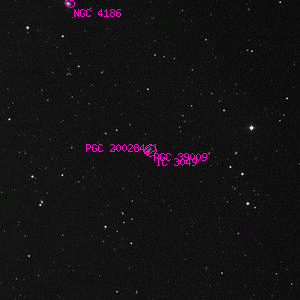IC 3049

Overlaid DSS image of IC 3049, 30' x 30' with north at top and west to the right
Aladin viewer for the region around IC 3049
UGC 7227, PGC 39009, SDSS J121333.35+142850.9
| Type | Galaxy Cluster |
|---|---|
| Magnitude | 15 |
| Size | 1.27' x 0.67' @ 122° |
| Right Ascension | 12h 13' 33.4" (2000) |
| Declination | 14° 28' 51" N |
| Constellation | Coma Berenices |
| Description | R, PN ?, mag 16 |
| Classification | Im(Im/S) |
Observing Notes
Harold Corwin
My previous interpretation of this object is a perfect case of what can happen given a lack of data. Here is what I said previously:IC 3049 is perhaps the southeastern of a pair of galaxies. Frost calls it "R, planetary?, magn 16" which will make it very small and faint in the grand scheme of things. I suspect the southeastern as it is a fairly compact elliptical with a bright nucleus, and would show up better on Frost's plate.The SDSS has clarified the situation here in a way that even the second DSS can't. The low surface brightness dwarf, an SAB?m in the SDSS image, is a member of the Virgo Cluster; its redshift is 2441 +- 5 km/s. It is superposed on a pair of distant galaxies, the brighter being the southeastern galaxy that I noted before, the second being the "bright knot (or superposed star?)". Both have redshifts in SDSS: the galaxy, an SAB?(sr?)a?, has a redshift of 19,037 +- 3 km/s, the fainter, perhaps an Sa? seen through the late-type dwarf, is at 19,127 +- 9 km/s.
However, the northwestern object, a low surface brightness IBm pec, may well be blended with its brighter neighbor on the plate. So, I've chosen the pair itself as the IC object, but give the individual positions, including one for a bright knot (or superposed star?) also involved in the image. Short of looking at the original plate, this is probably the best we can do.
So, the Virgo Cluster dwarf is superposed on a much more distant background pair. Given that Frost was working with a plate taken with a 24-inch telescope, all three objects must have been blended into a single image. So, at least my previous conclusion that the entire complex of three objects is the IC object is still correct. The mean position that I give for the IC object is based on the SDSS positions for the pair, and a mean of three of the USNO-B1.0 positions for the dwarf. Magnitudes and diameters are going to be fun to sort out...
Other Data Sources for IC 3049
Associated objects for IC 3049
Nearby objects for IC 3049
29 objects found within 60'
Credits...
Drawings, descriptions, and CCD photos are copyright Andrew Cooper unless otherwise noted, no usage without permission.
A complete list of credits and sources can be found on the about page
IC 3049